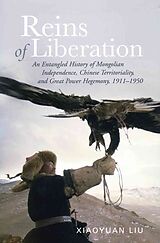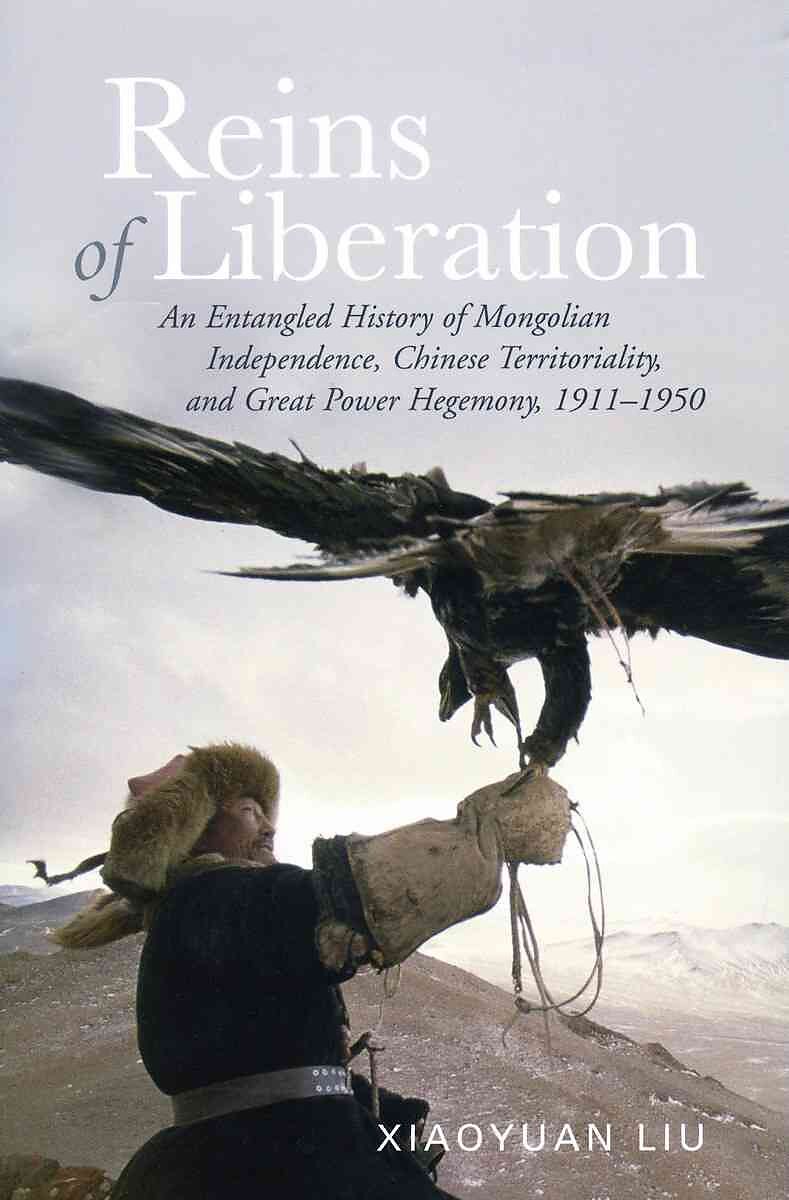Reins of Liberation
Einband:
Fester Einband
EAN:
9780804754262
Untertitel:
An Entangled History of Mongolian Independence, Chinese Territoriality, and Great Power Hegemony, 1911-1950
Genre:
Geschichte
Autor:
Xiaoyuan Liu
Herausgeber:
Stanford University Press
Anzahl Seiten:
506
Erscheinungsdatum:
15.09.2006
ISBN:
978-0-8047-5426-2
Zusatztext "This book is excellent. It is well written! with a personal touch that makes for interesting reading... It is a truly path-breaking study for our knowledge of Mongolian and Chinese histories! and ways of looking at them." Informationen zum Autor Xiaoyuan Liu is Associate Professor of History at Iowa State University and a recent Fellow at the Woodrow Wilson Center in Washington. He is author of Frontier Passages: Ethnopolitics and the Rise of Chinese Communism, 1921-1945 (Stanford University Press and the Woodrow Wilson Center Press, 2004). Klappentext "With the publication of this book, Mongolia and the Mongols will be central to any study of China's history of modern diplomacy, China's nationalism, communism, the Chinese Communist Party-Nationalist struggle for supremacy, and studies of ethnicity. A truly monumental piece of scholarship."--Uradyn E. Bulag, City University of New York Zusammenfassung Aims to use the Mongolian question to illuminate much larger issues of twentieth-century Asian history: how war, revolution, and great-power rivalries induced or restrained the formation of nationhood and territoriality. This book focuses on the Mongolian question, which ran through Chinese politics in the first half of the twentieth century. Inhaltsverzeichnis List of Maps Acknowledgments Introduction Part I Independence and Revolution, 1911-1945 1 China and Mongolia: From Empire to National States Facets of the Mongolia Question Independence for the Second Time Ethnic Separation and National Revolution Partisan, National, and Imperial Interests 2 "Red Protective Deity": World Revolution and Geopolitics Bolsheviks and Mongolian Partisans Eurasian Federation vs. Soviet Empire Divided Nation and Split Revolution 3 Dialectics of Brotherhood: The Chinese Communist Party and the Mongolian People's Republic Revolutionary Paradox Rally toward Periphery Return to Centrality Part II Autonomy and Civil War, 1945-1950 4 "National Fever": The Genesis of an Autonomous Movement From Colonialism to National Fever Liberation through Unification Degrees of Self-Government 5 Ethnic Strategy: The Eastern Mongolian Experience Chengde Concession Xing'an Interval Wangyemiao Finale 6 "Restoration": The Guomindang's Administrative Endeavor Delusive "Frontier Administration Abortive "Restoration Elusive "Loyalists 7 "Liberation": The Chinese Communist Party's Interethnic Approach Decide on a Strategy Awake to Spontaneity Secure "National Banner Enact "Leftist Excessiveness Part III Ethnicity and Hegemony, 1945-1950 8 "New Frontier":America's Encounter with Inner Mongolia Partisan Mongols Racial Mongols Change of Climate Princely Connection 9 The Range of "Wild Wind": Moscow's Inner Mongolia Stratagem A Sense of Limits Containing Nationalism Hierarchy of Patronage 10 The Structure of Bloc Politics: Mao, Stalin, and Mongolian Independence A Fractured Revolutionary Alliance Resetting the Interstate Relationship Between National and Bloc Interests Mongolian Independence, Again 11 Epilogue: Territoriality, Power, and Legitimacy A Note on Transliteration Acronyms and Abbreviations Bibliography Index ...
"This book is excellent. It is well written, with a personal touch that makes for interesting reading... It is a truly path-breaking study for our knowledge of Mongolian and Chinese histories, and ways of looking at them."
Autorentext
Xiaoyuan Liu is Associate Professor of History at Iowa State University and a recent Fellow at the Woodrow Wilson Center in Washington. He is author of Frontier Passages: Ethnopolitics and the Rise of Chinese Communism, 1921-1945 (Stanford University Press and the Woodrow Wilson Center Press, 2004).
Klappentext
"With the publication of this book, Mongolia and the Mongols will be central to any study of China's history of modern diplomacy, China's nationalism, communism, the Chinese Communist Party-Nationalist struggle for supremacy, and studies of ethnicity. A truly monumental piece of scholarship."--Uradyn E. Bulag, City University of New York
Zusammenfassung
Aims to use the Mongolian question to illuminate much larger issues of twentieth-century Asian history: how war, revolution, and great-power rivalries induced or restrained the formation of nationhood and territoriality. This book focuses on the Mongolian question, which ran through Chinese politics in the first half of the twentieth century.
Inhalt
List of Maps
Acknowledgments
Introduction
Part I Independence and Revolution, 1911-1945
1 China and Mongolia: From Empire to National States
Facets of the Mongolia Question
Independence for the Second Time
Ethnic Separation and National Revolution
Partisan, National, and Imperial Interests
2 "Red Protective Deity": World Revolution and Geopolitics
Bolsheviks and Mongolian Partisans
Eurasian Federation vs. Soviet Empire
Divided Nation and Split Revolution
3 Dialectics of Brotherhood: The Chinese Communist Party and the Mongolian People's Republic
Revolutionary Paradox
Rally toward Periphery
Return to Centrality
Part II Autonomy and Civil War, 1945-1950
4 "National Fever": The Genesis of an
Autonomous Movement
From Colonialism to National Fever
Liberation through Unification
Degrees of Self-Government
5 Ethnic Strategy: The Eastern Mongolian Experience
Chengde Concession
Xing'an Interval
Wangyemiao Finale
6 "Restoration": The Guomindang's Administrative Endeavor
Delusive "Frontier Administration
Abortive "Restoration
Elusive "Loyalists
7 "Liberation": The Chinese Communist Party's Interethnic Approach
Decide on a Strategy
Awake to Spontaneity
Secure "National Banner
Enact "Leftist Excessiveness
Part III Ethnicity and Hegemony, 1945-1950
8 "New Frontier":America's Encounter with Inner Mongolia
Partisan Mongols
Racial Mongols
Change of Climate
Princely Connection
9 The Range of "Wild Wind": Moscow's Inner Mongolia Stratagem
A Sense of Limits
Containing Nationalism
Hierarchy of Patronage
10 The Structure of Bloc Politics: Mao, Stalin, and Mongolian Independence
A Fractured Revolutionary Alliance
Resetting the Interstate Relationship
Between National and Bloc Interests
Mongolian Independence, Again
11 Epilogue: Territoriality, Power, and Legitimacy
A Note on Transliteration
Acronyms and Abbreviations
Bibliography
Index

Leider konnten wir für diesen Artikel keine Preise ermitteln ...
billigbuch.ch sucht jetzt für Sie die besten Angebote ...
Die aktuellen Verkaufspreise von 6 Onlineshops werden in Realtime abgefragt.
Sie können das gewünschte Produkt anschliessend direkt beim Anbieter Ihrer Wahl bestellen.
Loading...
Die aktuellen Verkaufspreise von 6 Onlineshops werden in Realtime abgefragt.
Sie können das gewünschte Produkt anschliessend direkt beim Anbieter Ihrer Wahl bestellen.
| # | Onlineshop | Preis CHF | Versand CHF | Total CHF | ||
|---|---|---|---|---|---|---|
| 1 | Seller | 0.00 | 0.00 | 0.00 |
